Docs Perform First-Ever Successful Interventions On Ensnared Grauer’s Gorillas
By Gorilla Doctors Staff on Wednesday, September 26th, 2012 in Blog.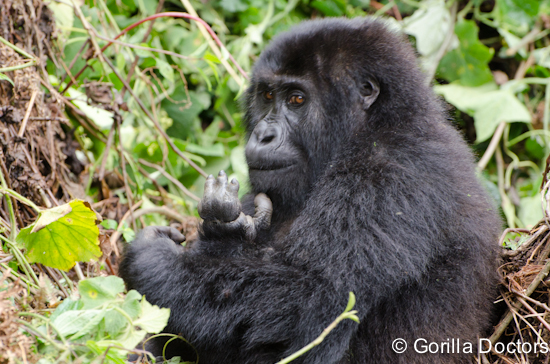 Pili Pili holds her ensnared left foot.By Molly Feltner
Pili Pili holds her ensnared left foot.By Molly Feltner
Amidst all of the news about the rescues of two new orphan Grauer’s gorillas, we haven’t been able to share all of the details about an important success story in Grauer’s gorilla conservation. On September 15, the same day Isangi was transferred to Virunga National Park with Dr. Martin, Drs. Dawn and Eddy performed the first-ever successful interventions to release wild Grauer’s gorillas from poachers’ snares. The gorillas, Numbi and Pili Pili, belong to the Chimanuka family, the only fully habituated group of Grauer’s gorillas in Kahuzi-Biega National Park, Democratic Republic of Congo (DRC).
Unlike mountain gorilla habitat, the regions where Grauer’s gorillas live in Eastern DRC—portions of Kahuzi-Biega, Virunga, and Mikeo National Parks as well as several forest reserves—have been extremely difficult to access over the past several decades. Due to civil war, rebel conflict, and intensive illegal resource extraction, park authorities and conservation groups like Gorilla Doctors have not been able to closely monitor Grauer’s gorillas. Comprehensive population censuses have been impossible to carry out, but experts estimate there may be fewer than 4,000 Grauer’s gorillas.
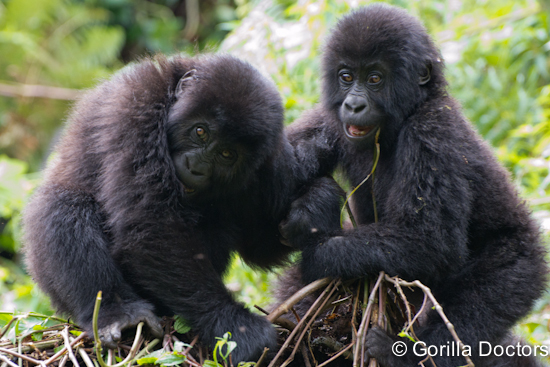 Healthy Grauer’s gorillas in Kahuzi-Biega National Park.The best known population of Grauer’s gorillas live in the 600-square-kilometer highland sector of Kahuzi-Biega National Park where a 2010 census counted 181animals. Thirty-five of these gorillas, including the 34-member Chimanuka family and lone silverback Mugaruka, are fully habituated to the presence of people to support gorilla ecotourism, which provides much needed revenue for maintaining and patrolling the park.
Healthy Grauer’s gorillas in Kahuzi-Biega National Park.The best known population of Grauer’s gorillas live in the 600-square-kilometer highland sector of Kahuzi-Biega National Park where a 2010 census counted 181animals. Thirty-five of these gorillas, including the 34-member Chimanuka family and lone silverback Mugaruka, are fully habituated to the presence of people to support gorilla ecotourism, which provides much needed revenue for maintaining and patrolling the park.
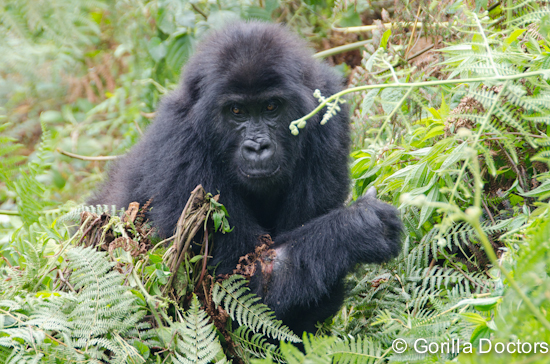 Numbi holds up her ensnared right arm.Drs. Eddy and Martin visited Kahuzi-Biega on September 11 to perform a routine health check on Chimanuka family and discovered that Pili Pili had a wire poacher’s snare around her left foot. The following day, the Gorilla Doctors veterinarians also noticed that Numbi had a snare around her right arm. Dr. Dawn quickly traveled to the park from the Gorilla Doctors headquarters in Musanze, Rwanda, bringing darting equipment and medicine to treat the animals.
Numbi holds up her ensnared right arm.Drs. Eddy and Martin visited Kahuzi-Biega on September 11 to perform a routine health check on Chimanuka family and discovered that Pili Pili had a wire poacher’s snare around her left foot. The following day, the Gorilla Doctors veterinarians also noticed that Numbi had a snare around her right arm. Dr. Dawn quickly traveled to the park from the Gorilla Doctors headquarters in Musanze, Rwanda, bringing darting equipment and medicine to treat the animals.
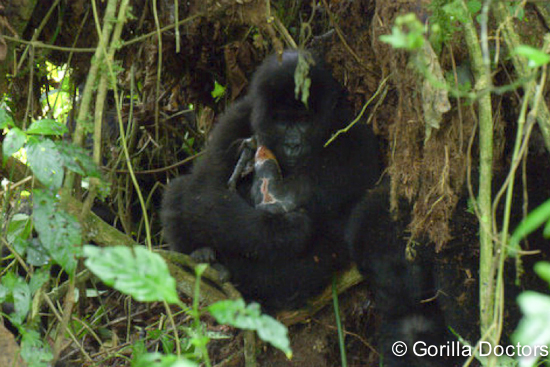 Meteo and his dead ensnared hand in 2010.Unlike the habituated mountain gorilla groups of Rwanda, which been have been monitored closely for years and have experienced numerous veterinary interventions, the Chimanuka family was not accustomed to the Gorilla Doctors. While no gorillas are fully comfortable with medical interventions, the Chimanuka family proved especially uncooperative when the Gorilla Doctors attempted to intervene on the ensnared juvenile male Meteo in 2010. The silverback Chimanuka and his family members would not allow the veterinarians near Meteo, even after Meteo was sedated. Meteo’s ensnared arm, which was already severely compromised due to lack of blood supply when the intervention was attempted, later sloughed off, leaving Meteo with a stump.
Meteo and his dead ensnared hand in 2010.Unlike the habituated mountain gorilla groups of Rwanda, which been have been monitored closely for years and have experienced numerous veterinary interventions, the Chimanuka family was not accustomed to the Gorilla Doctors. While no gorillas are fully comfortable with medical interventions, the Chimanuka family proved especially uncooperative when the Gorilla Doctors attempted to intervene on the ensnared juvenile male Meteo in 2010. The silverback Chimanuka and his family members would not allow the veterinarians near Meteo, even after Meteo was sedated. Meteo’s ensnared arm, which was already severely compromised due to lack of blood supply when the intervention was attempted, later sloughed off, leaving Meteo with a stump.
This time, with two gorillas needing help and the extremely protective silverback Chimanuka still in control of the group, the Gorilla Doctors and rangers were unsure if they could successfully intervene. However, both Numbi and Pili Pili’s limbs looked viable, so it was essential to remove the snares in order to prevent gangrene and the loss of the limbs.
 Dr. Eddy tries in vain to find a good shot.On September 13 Drs. Eddy, Dawn, and Martin, and Dr. Kizito, the Kahuzi-Biega veterinarian, had a hard time finding an opportunity to dart either animal because of heavy rain and thick vegetation. Dr. Eddy managed to dart Numbi in the afternoon but the dart failed to inject the sedative drug. Afterwards, Chimanuka moved his family into even denser bush to avoid contact with the intervention team. The next day, good darting opportunities again evaded the veterinarians.
Dr. Eddy tries in vain to find a good shot.On September 13 Drs. Eddy, Dawn, and Martin, and Dr. Kizito, the Kahuzi-Biega veterinarian, had a hard time finding an opportunity to dart either animal because of heavy rain and thick vegetation. Dr. Eddy managed to dart Numbi in the afternoon but the dart failed to inject the sedative drug. Afterwards, Chimanuka moved his family into even denser bush to avoid contact with the intervention team. The next day, good darting opportunities again evaded the veterinarians.
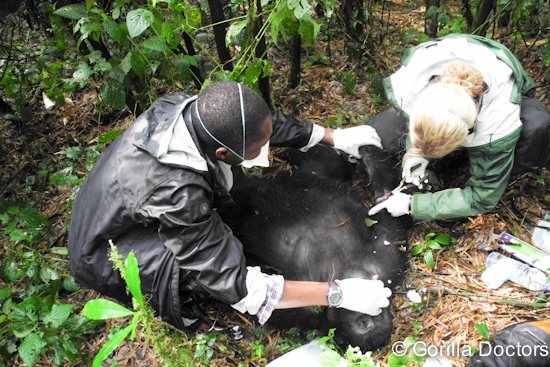 Drs. Dawn and Eddy work on Numbi.On the third day, September 15, the Gorilla Doctors and Kahuzi-Biega team left very early in the morning and located the group easily. At 9 a.m., Dr. Eddy successfully darted Numbi and she fell asleep within minutes. The team quickly cut the snare from Numbi’s arm. The snare had caused some swelling and cut through her skin and some underlying tissue, but the tissue did not seem overly infected and bled well, meaning that it was still viable. Her wounds were flushed and cleaned and she was injected with antibiotics and ant-inflammatory drugs to aid healing. At 9:32 a.m. Dr. Dawn gave her a reversal drug and she was on her feet in six minutes. Trackers stayed with her while she made her way back to the group.
Drs. Dawn and Eddy work on Numbi.On the third day, September 15, the Gorilla Doctors and Kahuzi-Biega team left very early in the morning and located the group easily. At 9 a.m., Dr. Eddy successfully darted Numbi and she fell asleep within minutes. The team quickly cut the snare from Numbi’s arm. The snare had caused some swelling and cut through her skin and some underlying tissue, but the tissue did not seem overly infected and bled well, meaning that it was still viable. Her wounds were flushed and cleaned and she was injected with antibiotics and ant-inflammatory drugs to aid healing. At 9:32 a.m. Dr. Dawn gave her a reversal drug and she was on her feet in six minutes. Trackers stayed with her while she made her way back to the group.
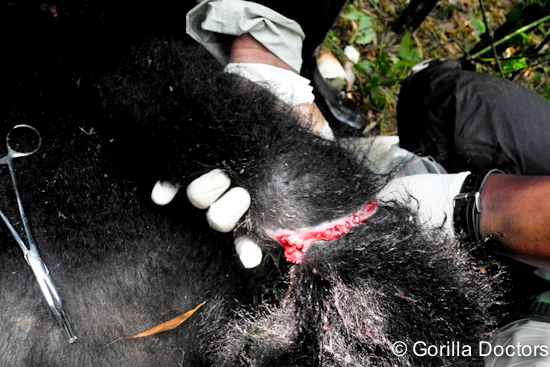 Numbi’s wound.With Numbi successfully treated, the team quickly set out to locate Pili Pili. Two hours later, when the gorillas moved to a more open swampy area, Dr. Eddy took a shot. Pili Pili ran into the center of the group and was lost for about 20 minutes until she was spotted propped up against a tree. The ranger team formed a wall around her and moved the other gorillas away so that Drs. Eddy and Dawn could safely work. Pili Pili needed an extra sedative injection but was asleep by 11:49 a.m.
Numbi’s wound.With Numbi successfully treated, the team quickly set out to locate Pili Pili. Two hours later, when the gorillas moved to a more open swampy area, Dr. Eddy took a shot. Pili Pili ran into the center of the group and was lost for about 20 minutes until she was spotted propped up against a tree. The ranger team formed a wall around her and moved the other gorillas away so that Drs. Eddy and Dawn could safely work. Pili Pili needed an extra sedative injection but was asleep by 11:49 a.m.
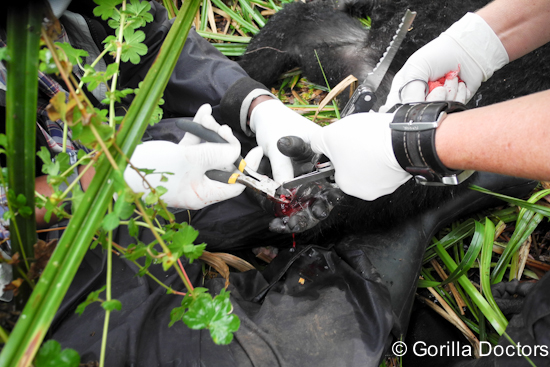 Removing Pili Pili’s snarePili Pili’s snare was much more deeply embedded than Numbi’s. The wire cut into her skin and the subcutaneous tissue around the bones of four toes. Extra care was needed when removing the snare to prevent further injury. While damaged, Pili Pili’s toes showed no evidence of gangrene and were warm to the touch, indicating that the digits were still receiving blood. As with Numbi, the Gorilla Doctors disinfected the wounds and administered antibiotic and ant-inflammatory drugs. She was reversed at 12:22 p.m. and by 12:45 p.m. she moved off with silverback Chimamuka.
Removing Pili Pili’s snarePili Pili’s snare was much more deeply embedded than Numbi’s. The wire cut into her skin and the subcutaneous tissue around the bones of four toes. Extra care was needed when removing the snare to prevent further injury. While damaged, Pili Pili’s toes showed no evidence of gangrene and were warm to the touch, indicating that the digits were still receiving blood. As with Numbi, the Gorilla Doctors disinfected the wounds and administered antibiotic and ant-inflammatory drugs. She was reversed at 12:22 p.m. and by 12:45 p.m. she moved off with silverback Chimamuka.
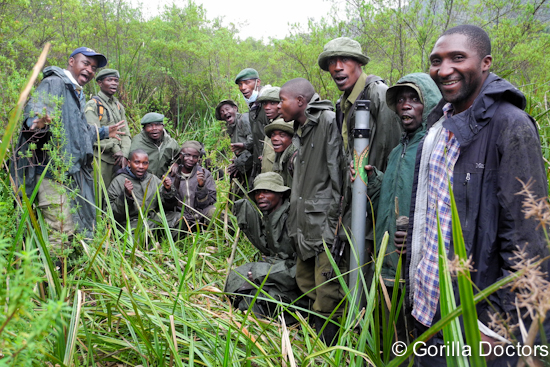 The team after the intervention.The prognosis for both gorillas was good although there was a possibility of infection, so the rangers needed to monitor them carefully over the following days. The rangers couldn’t get a clear view of either on September 16 but the next day they observed Numbi and Pili Pili and reported that both looked well. The gorillas will continue to be monitored by the rangers and the Gorilla Doctors will return in October to assess their recoveries.
The team after the intervention.The prognosis for both gorillas was good although there was a possibility of infection, so the rangers needed to monitor them carefully over the following days. The rangers couldn’t get a clear view of either on September 16 but the next day they observed Numbi and Pili Pili and reported that both looked well. The gorillas will continue to be monitored by the rangers and the Gorilla Doctors will return in October to assess their recoveries.
You can follow the Gorilla Doctors health monitoring efforts on our Facebook page, where we post photos and notes from our monthly visits.
Please consider supporting us by making a secure online donation. Every dollar you give goes to directly supporting our gorilla health programs and One Health initiative. Thank you for your generosity.


 Donate
Donate